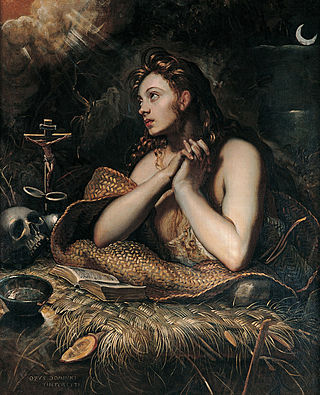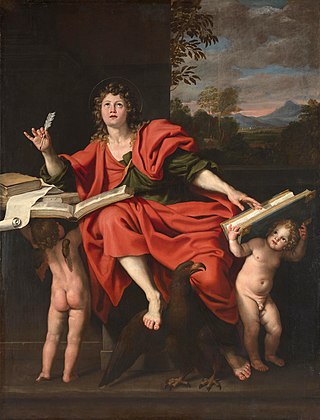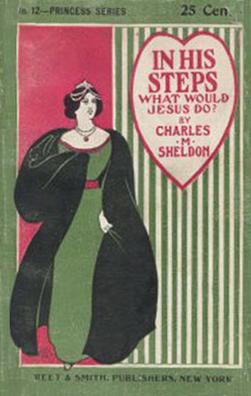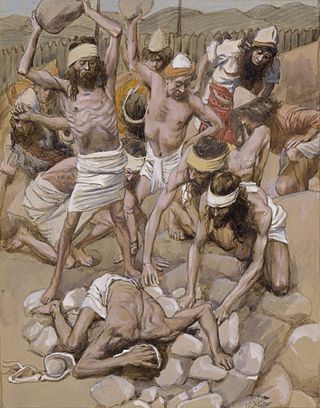Related Research Articles

Mary Magdalene was a woman who, according to the four canonical gospels, traveled with Jesus as one of his followers and was a witness to his crucifixion and resurrection. She is mentioned by name twelve times in the canonical gospels, more than most of the apostles and more than any other woman in the gospels, other than Jesus's family. Mary's epithet Magdalene may be a toponymic surname, meaning that she came from the town of Magdala, a fishing town on the western shore of the Sea of Galilee in Roman Judea.

Mary of Bethany is a biblical figure mentioned by name in the Gospel of John and probably the Gospel of Luke in the Christian New Testament. Together with her siblings Lazarus and Martha, she is described as living in the village of Bethany, a small village in Judaea to the south of the Mount of Olives near Jerusalem.

The Last Temptation of Christ or The Last Temptation is a historical novel written by Nikos Kazantzakis, first published in its original Greek in 1955 before being translated into English in 1960. The novel depicts the life of Jesus and his struggles with various forms of temptation, including fear, doubt, depression, reluctance, and lust.

Sacrifice is the offering of material possessions or the lives of animals or humans to a deity as an act of propitiation or worship. Evidence of ritual animal sacrifice has been seen at least since ancient Hebrews and Greeks, and possibly existed before that. Evidence of ritual human sacrifice can also be found back to at least pre-Columbian civilizations of Mesoamerica as well as in European civilizations. Varieties of ritual non-human sacrifices are practiced by numerous religions today.

Martha is a biblical figure described in the Gospels of Luke and John. Together with her siblings Lazarus and Mary of Bethany, she is described as living in the village of Bethany near Jerusalem and witnessing Jesus resurrecting her brother, Lazarus.

In the New Testament, Salome was a follower of Jesus who appears briefly in the canonical gospels and in apocryphal writings. She is named by Mark as present at the crucifixion and as one of the Myrrhbearers, the women who found Jesus's empty tomb. Interpretation has further identified her with other women who are mentioned but not named in the canonical gospels. In particular, she is often identified as the wife of Zebedee, the mother of James and John, two of the Twelve apostles. In medieval tradition Salome was counted as one of the Three Marys who were daughters of Saint Anne, so making her the sister or half-sister of Mary, mother of Jesus.

Saint Nino was a woman who preached Christianity in the territory of the Kingdom of Iberia, in what is modern-day Georgia. Her preaching resulted in the Christianization of Iberia.

The phrase "the disciple whom Jesus loved" or, in John 20:2; "the other disciple whom Jesus loved", is used six times in the Gospel of John, but in no other New Testament accounts of Jesus. John 21:24 states that the Gospel of John is based on the written testimony of this disciple.

Eucharistic theology is a branch of Christian theology which treats doctrines concerning the Holy Eucharist, also commonly known as the Lord's Supper and Holy Communion.

In His Steps is a religious fiction novel written by Charles Monroe Sheldon. First published in 1896, the book has sold more than 50 million copies and ranks as one of the bestselling books of all time. The full title of the book is In His Steps: What Would Jesus Do?

Nazarín is a 1959 Mexican satirical drama film directed by Luis Buñuel and co-written between Buñuel and Julio Alejandro, adapted from the eponymous novel of Benito Pérez Galdós.

Lazarus of Bethany is a figure of the New Testament whose life is restored by Jesus four days after his death, as told in the Gospel of John. The resurrection is considered one of the miracles of Jesus. In the Eastern Orthodox Church, Lazarus is venerated as Righteous Lazarus, the Four-Days Dead. The Eastern Orthodox and Catholic traditions offer varying accounts of the later events of his life.

Eucharist is the name that Catholic Christians give to the sacrament by which, according to their belief, the body and blood of Christ are present in the bread and wine consecrated during the Catholic eucharistic liturgy, generally known as the Mass. The definition of the Eucharist in the 1983 Code of Canon Law as the sacrament where Christ himself “is contained, offered, and received” points to the three aspects of the Eucharist according to Catholic theology: the real presence of Christ in the Eucharist, Holy Communion, and the holy sacrifice of the Mass.

Women in the Bible are wives, mothers and daughters, servants, slaves and prostitutes. As both victors and victims, some women in the Bible change the course of important events while others are powerless to affect even their destinies. The majority of women in the Bible are anonymous and unnamed. Individual portraits of various women in the Bible show women in various roles. The New Testament refers to a number of women in Jesus' inner circle, and scholars generally see him as dealing with women with respect and even equality.

James Robison is an American televangelist and the founder and President of the Christian relief organization Life Outreach International.
Mediator Dei is a papal encyclical issued by Pope Pius XII on 20 November 1947. It was the first encyclical devoted entirely to liturgy.

Sex and gender roles in the Roman Catholic Church have been the subject of both intrigue and controversy throughout the Church's history. The cultural influence of the Catholic Church has been vast, particularly upon Western society. Christian concepts, introduced into evangelized societies worldwide by the Church, had a significant impact on established cultural views of sex and gender roles. Human sacrifice, slavery, infanticide and polygamy practiced by cultures such as those of the Roman Empire, Europe, Latin America and parts of Africa came to an end through Church evangelization efforts. Historians note that Catholic missionaries, popes and religious were among the leaders in campaigns against slavery, an institution that has existed in almost every culture and often included sexual slavery of women. Christianity affected the status of women in evangelized cultures like the Roman Empire by condemning infanticide, divorce, incest, polygamy and marital infidelity of both men and women. Some critics say the Church and teachings by St. Paul, the Church Fathers, and scholastic theologians perpetuated a notion that female inferiority was divinely ordained, while current Church teaching considers women and men to be equal, different, and complementary.

Jesus's interactions with women are an important element in the theological debate about Christianity and women. Women are prominent in the story of Jesus. According to the resurrection story, the resurrected Jesus was first seen by women.
Melancholia is a 2008 Philippine black and white slow drama film shot, edited, composed, written, produced and directed by Lav Diaz. It won the Horizons prize at the 65th Venice International Film Festival.

Capital punishment in the Bible refers to instances in the Bible where death is called for as a punishment and also instances where it is proscribed or prohibited. A case against capital punishment can be made from John 8, where Jesus speaks words that can be construed as condemning the practice. There are however many more Bible verses that command and condone capital punishment, and examples of it being carried out. Sins that were punishable by death include homicide, striking one's parents, kidnapping, cursing one's parents, witchcraft and divination, bestiality, worshiping other gods, violating the Sabbath, child sacrifice, adultery, incest, and male homosexual intercourse.
References
- ↑ Burbidge, John W. (August 1992). "Religion in Morley Callaghans Such Is My Beloved". Journal of Canadian Studies. 27 (3): 105–114. doi:10.3138/jcs.27.3.105. ISSN 0021-9495.
- ↑ "Book Reviews, Sites, Romance, Fantasy, Fiction". Kirkus Reviews. Retrieved 2023-03-13.